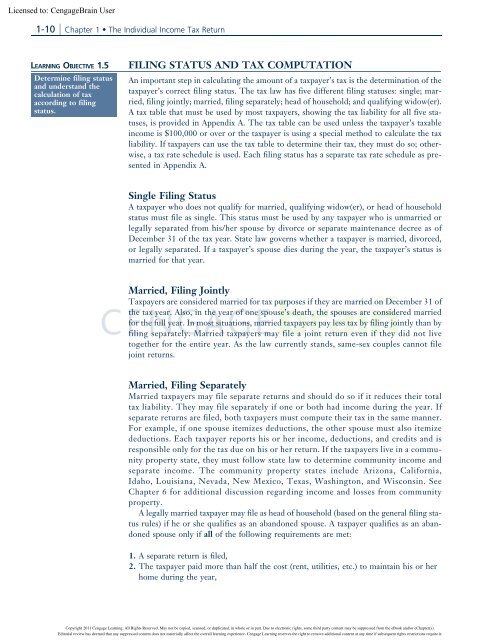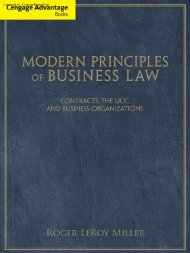Income Tax Fundamentals 2012, 30th ed. - CengageBrain
Income Tax Fundamentals 2012, 30th ed. - CengageBrain
Income Tax Fundamentals 2012, 30th ed. - CengageBrain
Create successful ePaper yourself
Turn your PDF publications into a flip-book with our unique Google optimized e-Paper software.
Licens<strong>ed</strong> to:<br />
1-10 Chapter 1 The Individual <strong>Income</strong> <strong>Tax</strong> Return<br />
LEARNING OBJECTIVE 1.5 FILING STATUS AND TAX COMPUTATION<br />
Determine filing status<br />
and understand the<br />
calculation of tax<br />
according to filing<br />
status.<br />
An important step in calculating the amount of a taxpayer’s tax is the determination of the<br />
taxpayer’s correct filing status. The tax law has five different filing statuses: single; marri<strong>ed</strong>,<br />
filing jointly; marri<strong>ed</strong>, filing separately; head of household; and qualifying widow(er).<br />
A tax table that must be us<strong>ed</strong> by most taxpayers, showing the tax liability for all five statuses,<br />
is provid<strong>ed</strong> in Appendix A. The tax table can be us<strong>ed</strong> unless the taxpayer’s taxable<br />
income is $100,000 or over or the taxpayer is using a special method to calculate the tax<br />
liability. If taxpayers can use the tax table to determine their tax, they must do so; otherwise,<br />
a tax rate sch<strong>ed</strong>ule is us<strong>ed</strong>. Each filing status has a separate tax rate sch<strong>ed</strong>ule as present<strong>ed</strong><br />
in Appendix A.<br />
Single Filing Status<br />
A taxpayer who does not qualify for marri<strong>ed</strong>, qualifying widow(er), or head of household<br />
status must file as single. This status must be us<strong>ed</strong> by any taxpayer who is unmarri<strong>ed</strong> or<br />
legally separat<strong>ed</strong> from his/her spouse by divorce or separate maintenance decree as of<br />
December 31 of the tax year. State law governs whether a taxpayer is marri<strong>ed</strong>, divorc<strong>ed</strong>,<br />
or legally separat<strong>ed</strong>. If a taxpayer’s spouse dies during the year, the taxpayer’s status is<br />
marri<strong>ed</strong> for that year.<br />
Marri<strong>ed</strong>, Filing Jointly<br />
<strong>Tax</strong>payers are consider<strong>ed</strong> marri<strong>ed</strong> for tax purposes if they are marri<strong>ed</strong> on December 31 of<br />
the tax year. Also, in the year of one spouse’s death, the spouses are consider<strong>ed</strong> marri<strong>ed</strong><br />
for the full year. In most situations, marri<strong>ed</strong> taxpayers pay less tax by filing jointly than by<br />
filing separately. Marri<strong>ed</strong> taxpayers may file a joint return even if they did not live<br />
together for the entire year. As the law currently stands, same-sex couples cannot file<br />
joint returns.<br />
Marri<strong>ed</strong>, Filing Separately<br />
Marri<strong>ed</strong> taxpayers may file separate returns and should do so if it r<strong>ed</strong>uces their total<br />
tax liability. They may file separately if one or both had income during the year. If<br />
separate returns are fil<strong>ed</strong>, both taxpayers must compute their tax in the same manner.<br />
For example, if one spouse itemizes d<strong>ed</strong>uctions, the other spouse must also itemize<br />
d<strong>ed</strong>uctions. Each taxpayer reports his or her income, d<strong>ed</strong>uctions, and cr<strong>ed</strong>its and is<br />
responsible only for the tax due on his or her return. If the taxpayers live in a community<br />
property state, they must follow state law to determine community income and<br />
separate income. The community property states include Arizona, California,<br />
Idaho, Louisiana, Nevada, New Mexico, Texas, Washington, and Wisconsin. See<br />
Chapter 6 for additional discussion regarding income and losses from community<br />
property.<br />
A legally marri<strong>ed</strong> taxpayer may file as head of household (bas<strong>ed</strong> on the general filing status<br />
rules) if he or she qualifies as an abandon<strong>ed</strong> spouse. A taxpayer qualifies as an abandon<strong>ed</strong><br />
spouse only if all of the following requirements are met:<br />
1. A separate return is fil<strong>ed</strong>,<br />
2. The taxpayer paid more than half the cost (rent, utilities, etc.) to maintain his or her<br />
home during the year,<br />
Copyright 2011 Cengage Learning. All Rights Reserv<strong>ed</strong>. May not be copi<strong>ed</strong>, scann<strong>ed</strong>, or duplicat<strong>ed</strong>, in whole or in part. Due to electronic rights, some third party content may be suppress<strong>ed</strong> from the eBook and/or eChapter(s).<br />
Editorial review has deem<strong>ed</strong> that any suppress<strong>ed</strong> content does not materially affect the overall learning experience. Cengage Learning reserves the right to remove additional content at any time if subsequent rights restrictions require it.










